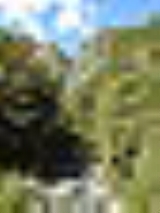
Species diversity
Encyclopedia
Species diversity is an index that incorporates the number of species in an area and also their relative abundance
. It is a more comprehensive value than species richness
.
The most common index of species diversity is a family of equations called Simpson's Diversity Index
.
Here is one such example
D = (n / N)2
Where n is the total number of organisms of a particular species and N is the total number of organisms of all species. D is the value of diversity. It can range between 0 and 1, where 0 is infinite diversity, and 1 is the least diverse an ecosystem can possibly be (i.e. only one species present).
Humans have a huge effect on species diversity; the main reasons are:
Relative species abundance
Relative species abundance is a component of biodiversity and refers to how common or rare a species is relative to other species in a defined location or community...
. It is a more comprehensive value than species richness
Species richness
Species richness is the number of different species in a given area. It is represented in equation form as S.Species richness is the fundamental unit in which to assess the homogeneity of an environment. Typically, species richness is used in conservation studies to determine the sensitivity of...
.
The most common index of species diversity is a family of equations called Simpson's Diversity Index
Simpson index
Simpson's diversity index is one of a number of diversity indices, used to measure diversity. In ecology, it is often used to quantify the biodiversity of a habitat. It takes into account the number of species present, as well as the relative abundance of each species...
.
Here is one such example
D = (n / N)2
Where n is the total number of organisms of a particular species and N is the total number of organisms of all species. D is the value of diversity. It can range between 0 and 1, where 0 is infinite diversity, and 1 is the least diverse an ecosystem can possibly be (i.e. only one species present).
Humans have a huge effect on species diversity; the main reasons are:
- DestructionHabitat destructionHabitat destruction is the process in which natural habitat is rendered functionally unable to support the species present. In this process, the organisms that previously used the site are displaced or destroyed, reducing biodiversity. Habitat destruction by human activity mainly for the purpose of...
, modification and fragmentation of habitatHabitat fragmentationHabitat fragmentation as the name implies, describes the emergence of discontinuities in an organism's preferred environment , causing population fragmentation... - Introduction of exotic speciesIntroduced speciesAn introduced species — or neozoon, alien, exotic, non-indigenous, or non-native species, or simply an introduction, is a species living outside its indigenous or native distributional range, and has arrived in an ecosystem or plant community by human activity, either deliberate or accidental...
- Overharvesting
- Global climate changeClimate changeClimate change is a significant and lasting change in the statistical distribution of weather patterns over periods ranging from decades to millions of years. It may be a change in average weather conditions or the distribution of events around that average...
See also
- BiodiversityBiodiversityBiodiversity is the degree of variation of life forms within a given ecosystem, biome, or an entire planet. Biodiversity is a measure of the health of ecosystems. Biodiversity is in part a function of climate. In terrestrial habitats, tropical regions are typically rich whereas polar regions...
- DegeneracyDegeneracy (biology)Within biological systems, degeneracy refers to circumstances where structurally dissimilar components/modules/pathways can perform similar functions under certain conditions, but perform distinct functions in other conditions. Degeneracy is thus a relational property that requires comparing the...
- Ecosystem diversityEcosystem diversityEcosystem diversity refers to the diversity of a place at the level of ecosystems. The term differs from biodiversity, which refers to variation in species rather than ecosystems...
- Genetic diversityGenetic diversityGenetic diversity, the level of biodiversity, refers to the total number of genetic characteristics in the genetic makeup of a species. It is distinguished from genetic variability, which describes the tendency of genetic characteristics to vary....

